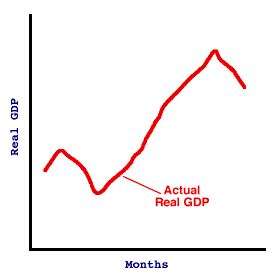
|
|
LABOR AGREEMENT: A formal, official, legal contract between a firm and the labor union representing the firm's employees. Such an agreement stipulates the various aspects of employment, including wages, fringe benefits, vacations, layoffs, promotions, and grievance procedures. The terms of the agreement are generally negotiated through the collective bargaining process. Should the collective bargaining process breakdown, the terms of the labor agreement might be helped along through a third-party mediator. If this doesn't help, then the labor union might call a strike or the firm might impose a lockout. Once in effect, any questions about the terms of the agreement are often subject to arbitration.
Visit the GLOSS*arama
|
|


|

|
                           LONG-RUN TREND: The pattern of potential real gross domestic product of an economy based on full employment of available resources. The long-run trend is commonly represented as a positively-sloped line in a diagram depicting business-cycle phases. This slope captures the economy's expansion in its production possibilities resulting from increases in the quantity and quality of resources. The long-run trend is a positively-sloped line on a diagram that plots the movement of actual real gross domestic product over time. It is primarily used to identify unemployment and inflation problems generated by the business-cycle instability. If actual real gross domestic product is below the long-run trend, then the economy is not living up to its full employment potential and the economy has in a contraction and unemployment. If actual real gross domestic product is above the long-run trend due to an expansion, then the economy is temporarily overshooting its full employment potential, and inflation is likely to occur. | Long Run Growth | 
|
The diagram displayed in this exhibit can be used to illustrate the macroeconomy's long-run trend. The red line represents the value of real gross domestic product (real GDP) over a period of several months. Clearly real GDP rises, then falls, then rises, then falls. This is the instability, the ups and downs, that are a fundamental part of business cycles.To reveal the long-run trend of real GDP, or potential real GDP, click the [Long-Run Trend] button. This blue line represents the amount of real GDP that the economy can produce if all resources are fully employed, resulting in potential real GDP. It has a positive slope because the economy's production capabilities increase over time due to increases in the quantity and quality of resources. Historically, this long-run trend represents approximately a 3 percent annual growth of production capabilities and potential real GDP. Clearly actual real GDP does not follow this long-run trend of potential real GDP. During some periods actual real GDP is greater than potential real GDP and in other periods actual real GDP is less than potential real GDP, indicated by the red line lying above or below the blue line. During some periods actual real GDP is growing faster than potential real GDP, in other periods actual real GDP is growing slower than potential real GDP, indicated by the red line having a steeper or flatter slope than the blue line. And in some cases actual real GDP declines even though potential real GDP continues to expand. The fact that actual real GDP does not coincide with the long-run trend of potential real GDP is the essence of business cycles and instability of the macroeconomy.

Recommended Citation:LONG-RUN TREND, AmosWEB Encyclonomic WEB*pedia, http://www.AmosWEB.com, AmosWEB LLC, 2000-2025. [Accessed: July 18, 2025].
Check Out These Related Terms... | | | | | | | | | |
Or For A Little Background... | | | | |
And For Further Study... | | | | | | | | | | | | | |
Related Websites (Will Open in New Window)... | | | |
Search Again?
Back to the WEB*pedia
|



|

|
BLUE PLACIDOLA
[What's This?]
Today, you are likely to spend a great deal of time searching the newspaper want ads looking to buy either a wall poster commemorating the first day of winter or blue cotton balls. Be on the lookout for rusty deck screws.
Your Complete Scope
This isn't me! What am I?
|

|
|
The standard "debt" notation I.O.U. does not mean "I owe you," but actually stands for "I owe unto..."
|

|
|
"A winner is someone who recognizes his God-given talents, works his tail off to develop them into skills, and uses those skills to accomplish his goals. " -- Larry Bird, basketball player
|

|
ILO
International Labor Office
|

|
|
Tell us what you think about AmosWEB. Like what you see? Have suggestions for improvements? Let us know. Click the User Feedback link.
User Feedback
|


|


